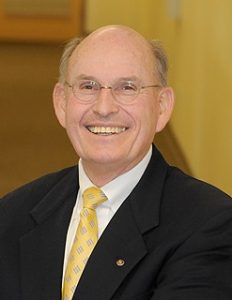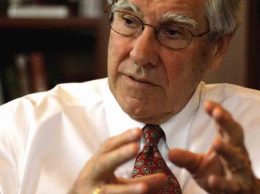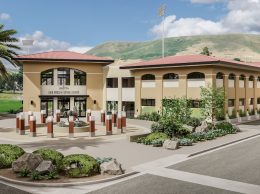Dubroff: Retiring Cuesta president predicts big changes for higher education
IN THIS ARTICLE
- Columns Topic
- Henry Dubroff Author
By Henry Dubroff Friday, September 1st, 2017

Cuesta College President Gil Stork
As the longest serving employee in Cuesta College history, Gil Stork knows a thing or two — which means that, with apologies to the folks at Farmers Insurance, he has seen a thing or two.
So, with the announcement in late August that he’d be stepping down on June 30, 2018, it seemed a good time to visit with him on the phone and hear what he thinks about the future of higher education and economic development on the Central Coast.
During his 50-year tenure as a teacher, athletic coach, administrator and president since 2010, one thing that Stork has seen is a mammoth change in the role that Cal Poly San Luis Obispo plays in the regional economy. It has become a job generating machine that’s turned SLO into a magnet for tech firms looking to grow; it’s also a constant source of graduate students for research universities such as UC Santa Barbara and increasingly a hub for startups.
For Cuesta, the rise of Cal Poly to national and global prominence is what he calls a “two-edged sword.” Cuesta gets a big chunk of Cal Poly transfers, roughly 200 out of 800 this past year, but that pales in demand for baccalaureate degree programs. Cuesta has turned to expensive private universities, including Brandman University and Columbia College of Missouri, to set up satellite facilities on its campus.
Another big development is the emergence of North SLO County as an economic powerhouse in viticulture, agritourism and a mix of software and other tech firms. A bond issue passed on Stork’s watch in 2014 — a landmark development — will allow Cuesta to build out much of its campus in Paso Robles, offering advanced agribusiness classes and a greater range of opportunities. He said North SLO County is an example of “an economic development plan that’s well thought out with access to education as a real factor.”
Amid good times for SLO County and the Central Coast, Stork is worried about the fact that the community colleges from Santa Barbara to Santa Cruz don’t have the kind of political clout shared by large districts in urban areas.
He’s been working with colleagues up and down the coast, creating an informal consortium that can speak up on issues like enrollment caps and the need for housing. They’ve been meeting with state Sen. Bill Monning (D-Carmel).
Stork also thinks that community colleges can play a bigger role in providing ongoing education to retirees moving into their communities.
“We have an ever-growing retirement population and a lack of young families with school age children,” he said.
Over the longer term, Stork thinks big changes are coming to traditional higher education, to wit:
• Certification programs will be on the rise: Stork said that for every 10 jobs, only one requires professional training and only two require a bachelor’s degree. The other seven require either an associate’s degree or a certification – whether it is for computer coding or a construction trade. “We need to work with local businesses and see what people are looking for in a worker,” he said.
• Online education will get better and better: Services provided to online students are performing at equal to or better levels than traditional classes, Stork said. “We have to be prepared, ready and nimble,” he added. “Millennials have a different set of expectations” about how higher education should be delivered.
• Community colleges will offer four-year options: Stork said that “California is going to have to follow suit with 26 other states with community colleges offering baccalaureates.” Service areas and majors will have to be defined but demand for four-year degrees, particularly for students already in the workforce, is outstripping supply.
• Promise programs are a game changer: Stork said that offering a cost-free first year of college has had a “big impact on first generation students, especially Latina females,” altering economic prospects for a generation. Cuesta wants to expand its program to a second year via a $10 million campaign.
After 45 minutes on the phone, it was obvious that Stork, at age 75, still has a powerful voice on education and economic development issues.
His next gig after he retires, he said, will be chairing the Monday noon Rotary at the Madonna Inn starting in 2018. But I have a feeling there’s a lot more to come.
• Reach Editor Henry Dubroff at hdubroff@pacbiztimes.com.
Related Articles
 Friday, October 14th, 2022
Friday, October 14th, 2022










